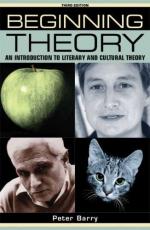
|
| Name: _________________________ | Period: ___________________ |
This test consists of 5 multiple choice questions, 5 short answer questions, and 10 short essay questions.
Multiple Choice Questions
1. Author Peter Barry explains that all of the following are part of the three stages of the deconstructive process except for which one?
(a) Visual.
(b) Linguistic.
(c) Verbal.
(d) Textual.
2. Which of the following terms best fit the following definition: "a form of literary criticism which uses some of the techniques of psychoanalysis in the interpretation of literature"?
(a) Practical criticism.
(b) Impressionistic criticism.
(c) Psychoanalytic criticism.
(d) Applied criticism.
3. Sigmund Freud believed that a ________ was an escape-hatch or safety-valve through which repressed desires, fears, or memories seek an outlet into the conscious mind.
(a) Fetish.
(b) Dream.
(c) Memoir.
(d) Poem.
4. Who was appointed Professor at King's College, London in 1840?
(a) J.R.R. Tolkien.
(b) Frank McCourt.
(c) F.D. Maurice.
(d) Nick Hornby.
5. ________ was founded on the notion of close reading, according to the narrator.
(a) English studies.
(b) Social studies.
(c) Humanities.
(d) Sociology.
Short Answer Questions
1. Lacan argues that the two "dream work" mechanisms identified by Freud correspond to the basic poles of language, identified by the linguist Roman Jakobson, to ________ and ________.
2. All of the following religious believers were not allowed to attend university in England in the nineteenth century except which one?
3. Author Peter Barry informs the reader that the feminist literary criticism of today was the direct product of the "women's movement" of the ________.
4. Which of the following works did the narrator believe to be the most important Lacanian text for literary students and which was first delivered in 1957 to a "lay" audience of philosophy students?
5. Peter Barry examines Sigmund Freud's book ________, which in the chapter "Psychoanalytic Criticism" Barry claims is one of Freud's most enjoyable and accessible publications.
Short Essay Questions
1. Discuss Sigmund Freud's concept of "dream work."
2. What is "ecriture feminine"?
3. What are the three particular areas that are debated and disagreed upon when it comes to feminist criticism?
4. What is a theoretical difference between structuralist and post-structuralist?
5. According to the "Introduction," what does the saying that "after the moment of theory comes the 'hour' of theory" mean?
6. Discuss how J.A. Cuddon describes postmodernism in his "Dictionary of Literary Terms and Literary Theory."
7. In which way is post-structuralism more fundamental than structuralism?
8. What is structuralism? Where and when did it begin?
9. What is the most basic difference between liberal humanist and structuralist reading?
10. What is the purpose of displacement and condensation?
|
This section contains 830 words (approx. 3 pages at 300 words per page) |

|




